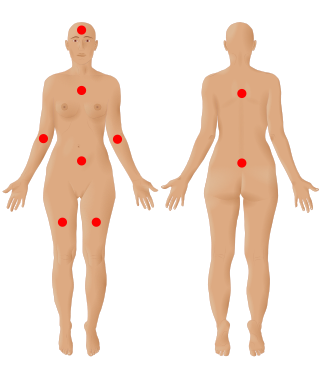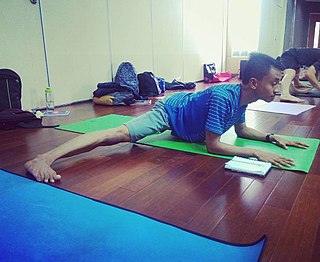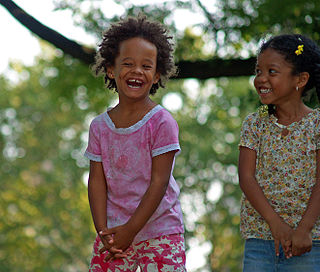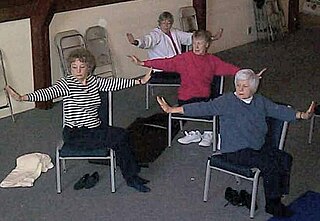
Cognitive behavioral therapy (CBT) is a psycho-social intervention that aims to reduce symptoms of various mental health conditions, primarily depression and anxiety disorders. Cognitive behavioral therapy is one of the most effective means of treatment for substance abuse and co-occurring mental health disorders. CBT focuses on challenging and changing cognitive distortions and their associated behaviors to improve emotional regulation and develop personal coping strategies that target solving current problems. Though it was originally designed to treat depression, its uses have been expanded to include many issues and the treatment of many mental health conditions, including anxiety, substance use disorders, marital problems, ADHD, and eating disorders. CBT includes a number of cognitive or behavioral psychotherapies that treat defined psychopathologies using evidence-based techniques and strategies.

Fibromyalgia is a medical condition which causes chronic widespread pain, accompanied by fatigue, waking unrefreshed and cognitive symptoms. Other symptoms include headaches, lower abdominal pain or cramps, and depression. People with fibromyalgia can also experience insomnia and a general hypersensitivity.
The Buteyko method or Buteyko Breathing Technique is a form of complementary or alternative physical therapy that proposes the use of breathing exercises primarily as a treatment for asthma and other respiratory conditions.

Pain management is an aspect of medicine and health care involving relief of pain in various dimensions, from acute and simple to chronic and challenging. Most physicians and other health professionals provide some pain control in the normal course of their practice, and for the more complex instances of pain, they also call on additional help from a specific medical specialty devoted to pain, which is called pain medicine.

Pilates is a type of mind-body exercise developed in the early 20th century by German physical trainer Joseph Pilates, after whom it was named. Pilates called his method "Contrology". It is practiced worldwide, especially in developed countries such as Australia, Canada, South Korea, the United Kingdom and the United States. Pilates uses a combination of around 50 repetitive exercises to spur muscle exertion. Each exercise flows from the "five essentials": breath, cervical alignment, rib and scapular stabilization, pelvic mobility, and utilization of the transversus abdominis. Each exercise is typically repeated three to five times. As of 2023, over 12 million people practice Pilates.
Mind–body interventions (MBI) or mind-body training (MBT) are health and fitness interventions that are intended to work on a physical and mental level such as yoga, tai chi, and Pilates.
Mindfulness is the cognitive skill, usually developed through meditation, of sustaining meta-attention of the contents of one's own mind in the present moment. Mindfulness derives from sati, a significant element of Hindu and Buddhist traditions, and is based on Zen, Vipassanā, and Tibetan meditation techniques. Though definitions and techniques of mindfulness are wide-ranging, Buddhist traditions describe what constitutes mindfulness such as how past, present and future moments arise and cease as momentary sense impressions and mental phenomena. Individuals who have contributed to the popularity of mindfulness in the modern Western context include Thích Nhất Hạnh, Joseph Goldstein, Herbert Benson, Jon Kabat-Zinn, and Richard J. Davidson.

Yoga as therapy is the use of yoga as exercise, consisting mainly of postures called asanas, as a gentle form of exercise and relaxation applied specifically with the intention of improving health. This form of yoga is widely practised in classes, and may involve meditation, imagery, breath work (pranayama) and calming music as well as postural yoga.
World Laughter Day was established in 1998 and the first celebration was on 10 May 1998, in Mumbai, India, arranged by Dr. Madan Kataria, founder of the worldwide Laughter Yoga movement.
Psycho-oncology is an interdisciplinary field at the intersection of physical, psychological, social, and behavioral aspects of the cancer experience for both patients and caregivers. Also known as psychiatric oncology or psychosocial oncology, researchers and practitioners in the field are concerned with aspects of individuals' experience with cancer beyond medical treatment, and across the cancer trajectory, including at diagnosis, during treatment, transitioning to and throughout survivorship, and approaching the end-of-life. Founded by Jimmie Holland in 1977 via the incorporation of a psychiatric service within the Memorial Sloan Kettering Cancer Center in New York, the field has expanded drastically since and is now universally recognized as an integral component of quality cancer care. Cancer centers in major academic medical centers across the country now uniformly incorporate a psycho-oncology service into their clinical care, and provide infrastructure to support research efforts to advance knowledge in the field.

Gelotology is the study of laughter and its effects on the body, from a psychological and physiological perspective. Its proponents often advocate induction of laughter on therapeutic grounds in alternative medicine. The field of study was pioneered by William F. Fry of Stanford University.
Conscious breathing encompasses techniques directing awareness toward the breathing process, serving purposes from improving respiration to building mindfulness. In martial arts like tai chi and qigong, breathing exercises are said to strengthen diaphragm muscles and protect organs, with reverse breathing being a common method. Meditation traditions, including yoga and Buddhist meditation, emphasize breath control. Yoga's pranayama is believed by practitioners to elevate life energies, while Buddhist vipassanā uses anapanasati for mindfulness of breathing.

The psychological and physiological effects of meditation have been studied. In recent years, studies of meditation have increasingly involved the use of modern instruments, such as fMRI and EEG, which are able to observe brain physiology and neural activity in living subjects, either during the act of meditation itself or before and after meditation. Correlations can thus be established between meditative practices and brain structure or function.
Aquatic therapy refers to treatments and exercises performed in water for relaxation, fitness, physical rehabilitation, and other therapeutic benefit. Typically a qualified aquatic therapist gives constant attendance to a person receiving treatment in a heated therapy pool. Aquatic therapy techniques include Ai Chi, Aqua Running, Bad Ragaz Ring Method, Burdenko Method, Halliwick, Watsu, and other aquatic bodywork forms. Therapeutic applications include neurological disorders, spine pain, musculoskeletal pain, postoperative orthopedic rehabilitation, pediatric disabilities, and pressure ulcers.
Cognitive remediation is designed to improve neurocognitive abilities such as attention, working memory, cognitive flexibility and planning, and executive functioning which leads to improved psychosocial functioning.
Mindfulness-based stress reduction (MBSR) is an eight-week evidence-based program that offers secular, intensive mindfulness training to assist people with stress, anxiety, depression and pain. Developed at the University of Massachusetts Medical Center in the 1970s by Professor Jon Kabat-Zinn, MBSR uses a combination of mindfulness meditation, body awareness, yoga and exploration of patterns of behavior, thinking, feeling and action. Mindfulness can be understood as the non-judgmental acceptance and investigation of present experience, including body sensations, internal mental states, thoughts, emotions, impulses and memories, in order to reduce suffering or distress and to increase well-being. Mindfulness meditation is a method by which attention skills are cultivated, emotional regulation is developed, and rumination and worry are significantly reduced. During the past decades, mindfulness meditation has been the subject of more controlled clinical research, which suggests its potential beneficial effects for mental health, athletic performance, as well as physical health. While MBSR has its roots in wisdom teachings of Zen Buddhism, Hatha Yoga, Vipassana and Advaita Vedanta, the program itself is secular. The MBSR program is described in detail in Kabat-Zinn's 1990 book Full Catastrophe Living.
How to Live Forever is a 2009 documentary film about longevity, written by Mark Wexler and Robert DeMaio. It is also directed by Wexler, and the film follows him on a three-year pilgrimage to discover the best practices and philosophies to help mitigate "the uncool trappings of old age." With the death of his mother and the arrival of an AARP card, Wexler begins to wonder if one can truly achieve immortality. He interviews an eclectic group of celebrities, health care professionals, centenarians, followers of Laughter Yoga, and scientists contemplating technology’s impact on the average lifespan in an attempt to conquer death.
Trauma-sensitive yoga is yoga as exercise, adapted from 2002 onwards for work with individuals affected by psychological trauma. Its goal is to help trauma survivors to develop a greater sense of mind-body connection, to ease their physiological experiences of trauma, to gain a greater sense of ownership over their bodies, and to augment their overall well-being. However, a 2019 systematic review found that the studies to date were not sufficiently robustly designed to provide strong evidence of yoga's effectiveness as a therapy; it called for further research.

The science of yoga is the scientific basis of modern yoga as physical exercise in human sciences such as anatomy, physiology, and psychology. Yoga's effects are to some extent shared with other forms of exercise, though it differs in the amount of stretching involved, and because of its frequent use of long holds and relaxation, in its ability to reduce stress. Yoga is here treated separately from meditation, which has effects of its own, though yoga and meditation are combined in some schools of yoga.

Accessible yoga is a form of modern yoga as exercise with adapted asanas designed to be suitable for people who are unable to follow a standard yoga class through age, illness, or disability. It includes various forms of what has been called Chair Yoga, and has also been described as adaptive yoga.










